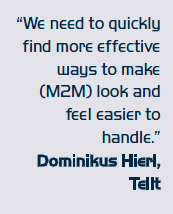It’s been a long time coming, says Dominikus Hierl, but the ‘App-ification’ of M2M is leading Industrial Internet providers to adopt a One Stop Shop approach. So, M2M Now asks Telit’s CMO why it’s only happening now and whether mobile network operators (MNOs) will join in.
M2M Now: Can you foresee disruptive technologies appearing in M2M communications from outside telecom and having an impact on the market in three or four years? Are there any reasons why M2M may still struggle to progress?
 Dominikus Hierl: All the ingredients are in place for that to happen. But, as is always the case with disruptive technologies, ingredients are fundamental but market timing and the model adequacy are actually the triggers.
Dominikus Hierl: All the ingredients are in place for that to happen. But, as is always the case with disruptive technologies, ingredients are fundamental but market timing and the model adequacy are actually the triggers.
You can clearly see the potential is there for it to happen with M2M. Our industry has been parading the technology and its capabilities in one way or another for over 12 years now which has provided the broader tech industry ample opportunity to begin resonating with the value proposition of connected devices. But M2M has such a fragmented value chain that as an industry, we need to quickly find more effective ways to make it look and feel easier to handle to adopters like GE and others before they will be ready and willing to take the M2M plunge.
Looking again at GE, the company’s many divisions have for a short while now been adding an immensity of sensors to everything they design from hospital imaging equipment to locomotives, wind turbines, and hydroelectric power generation components. The feeble extent to which they are able to make full use of these sensors and of the massive amounts of data they generate is irrelevant right this instant. GE, like many industrial giants are getting their machines ready to communicate in what they and I like to call the Industrial Internet.
M2M Now: There appears to be a recent surge in initiatives from large technology companies to do more about accelerating the adoption of the IoT (Internet of Things). What, if any, commonalities are there in these initiatives?
DH: We are certainly seeing names like GE, IBM, and Google now using a different vocabulary from before, signalling more of an embrace than reluctance regarding the Internet of Things.
We are also starting to see the technology sections of mainstream media outlets like the New York Times, and the Wall Street Journal carry more content on the Industrial Internet, M2M and the IoT. And when you read these stories, as I mentioned before, one common thread you glean is the need for M2M to become an enabling technology following much more closely the high-power white LED model for the light bulb industry. This is now what is incumbent upon all of us in the M2M space – to provide the tech industry this ‘ready-to-use’ approach they are asking for.
And we are seeing that happen. Some recently reported M&A activity involving M2M players seems to points to a trend with companies, particularly in hardware, acquiring software and services assets to augment their offerings, making them easier to integrate and to enable connected solutions.
At Telit, of course, we have been on this path for quite a while now. We have concluded several acquisitions, all with the objective of delivering this enhanced experience to large industrial adopters. And if we are meeting their requirements and targets, we are most certainly meeting those of other scale customers.
The need to change the way we package and deliver M2M in the form of products and services from dozens of different  vendors into manageable solutions from the perspective of the adopter is clear and present. It comes not only from the groundswell created by the bold statements from these large industrial players, but also from the shift in expectations from the technology industry. The ‘App’ effect has hit the industry, and potential adopters need M2M and the Industrial Internet to look and feel more like installing an app on your smartphone, if for no other reason, than because that is what their customers expect.
vendors into manageable solutions from the perspective of the adopter is clear and present. It comes not only from the groundswell created by the bold statements from these large industrial players, but also from the shift in expectations from the technology industry. The ‘App’ effect has hit the industry, and potential adopters need M2M and the Industrial Internet to look and feel more like installing an app on your smartphone, if for no other reason, than because that is what their customers expect.
When the smartphone revolution started a few years ago, none of us in the M2M industry could have imagined that something so distant in consumer electronics could possibly impact the dynamics of the largely B2B-based value chain that makes up our space. But it impacted it profoundly.
Connected products like building controls, security alarm panels, car infotainment and navigation systems now have to be as easy to use as a smartphone app and to pack ever-increasing functionality. The pressure this places on integrators and developers is passed down to us in the M2M value chain.
M2M Now: As you say, most of these initiatives follow the ‘One-Stop-Shop’ idea. Why is this?
DH: Again, it is the ‘App-ification’ of the Industrial Internet. All across the tech industry, companies and adopters want to see that kind of user experience. In order to deliver that in M2M, we need to package key pieces involved in connecting machines, as much as possible, into solutions. But even that is not enough – we also need to wrap all that with layers of valueadded services required to quickly enable complex yet easy-to-use customer applications.
Furthermore, all that needs to be available from the same vendor and fully integrated into the solutions in order to approximate this ‘App’ look and feel. So, when you look at what that is – you see it is the One Stop Shop. It is an entirely new delivery model for our industry, but it is clear there will be no mass adoption without it.
Year after year, even though forecasts for M2M keep going up in absolute numbers, if you look closer, you will see that analysts are taking ever smaller percentages of total available market of connectable machines which they believe will actually make it to M2M. This revision has to happen to adjust for the widening gap that has formed between our industry’s componentcentric delivery models and the mass adoption market we are exploring here. Fewer and fewer adopters are willing or able to take products and services this way. The answer is now right there for us to read and
implement, and the One Stop Shop race is on.
M2M Now: The cellular module that works outof- the-box is a valuable offering in the One Stop Shop. What is the role of traditional operators’ business models here?
DH: There are a few ways this can happen. All major operators have by now established internal M2M organisations – some have been running for a while, some are just getting started. They all offer rate plans specifically designed for M2M, some have strategic partnerships and some have taken equity stakes in companies covering value-added areas like service enablement platforms and so on.
There are services like our m2mAIR, however, that deliver high value benefits from service platforms reaching well inside the module and which make connected machines deliver better results. But these are too far outside the consumer models that operators typically have to use as the base for their M2M offerings. So far, not delivering this facility has
not surfaced as a major stumbling block, but it is likely to become one now that major adopter expectations are becoming clearer.
With the flurry of activity in this area, operators will need to figure out how they will handle this and other similar cases. One thing is certain though, the relationship between operators and M2M providers will continue changing and evolving.
M2M Now: How do large cellular operators arrive at an integrated One Stop Shop offering?
DH: It is hard to envision large cellular operators ever becoming One Stop Shops for M2M. There will always be demands from One Stop Shop customers that are fundamentally incompatible with the business models and operational constraints supporting consumer smartphones. And when you look at the dreaded ARPU (average revenue per user), still largely steering cellular operator decision-making, you start to see how decisions are going to go when ARPU for
connected machines is a mere fraction of the consumer number, and forecast by industry analysts to remain that way for the foreseeable future.
The way forward here has to go through partnering and collaboration. Operators and M2M value chain players have to come together and work to deliver these complete solutions looking to improve the total customer experience at the level of sophistication they require. Anything less than that will no longer do.
Telit is an active partner to a number of operators around the world, some global, some regional, just as these operators are in partnerships with other M2M providers. It is the norm for our industry. These alliances and the co-operation that ensues help us all create models that work, as well as determine those which do not.
M2M Now: Why is the market at the highest levels only now seeing the value of the One Stop Shop? Which of these One Stop Shop models are likely to succeed, and which are not?
DH: It’s happening now because the repackaging of M2M as the Internet of Things – and even the Industrial Internet as GE dubs it – has been a catalyst for adoption among large industrial players who have been on the sidelines until now. These open and positive statements – which, as I mentioned, have been made recently by heavyweights about adoption being a matter of ‘when’ and no longer ‘if’ – have propelled the supply side to snap into action heeding the demand for this better experience. At Telit we have been promoting and encapsulating this experience improvement with the One Stop Shop concept.
Currently, there are several One Stop Shop models coming together – and that is a good thing. It validates what we have been building at Telit for a decade now. The models we believe are more likely to succeed are those really focusing on and delivering improved adopter experience. Many will claim they are doing that but will under-deliver as they label as One Stop Shops, offerings that are nothing more than bundles of regular products from themselves and partners. This model has been tried and has not shown enough value aggregation to justify it.
The community of developers and integrators is working under tremendous pressure from their own customers. They are ready to embrace M2M but need us to understand the magnitude of that pressure and know that we are willing to create solutions that help relieve that pressure. In the end, those models that factor this into their solution designs will
surface as having delivered on the One Stop Shop promise.










